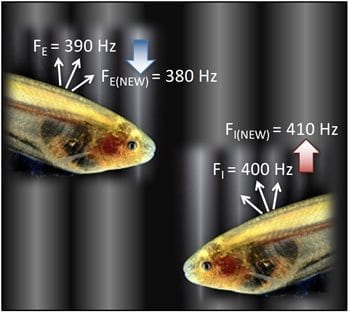
Nature-inspired device avoids jamming, could enable smarter and less expensive use of wireless communication bandwidth
For the first time, researchers have demonstrated a light-based device that mimics a fish’s incredible jamming avoidance response (JAR) by moving the frequency of an emitted signal away from other signals that could potentially cause interference. The new system could eventually help overcome the spectral bandwidth crunch caused by ever increasing numbers of wireless devices and transmitted data competing for space on a limited amount of available bandwidth.
Eigenmannia are cave-dwelling fish that live in complete darkness. To survive without the presence of light, the fish emit an electric field to communicate with other fish and to sense the surrounding environment. When two fish emit signals at similar frequencies they can interfere with each other, or jam, creating a scrambled signal. Thanks to a unique neural algorithm, these fish can adjust their electric communication signals so that they don’t interfere with those coming from other nearby fish.
“We think that humans could use the same jamming avoidance response neural algorithm as the Eigenmannia, but at a much faster speed and frequency,” said research team leader Mable P. Fok from the University of Georgia. “This could allow a smarter and more dynamic way to use our wireless communication systems without the need for the complicated coordination processes that currently prevent jamming by reserving whole sections of bandwidth for specific phone carriers or users such as the military.”
In The Optical Society (OSA) journal Optics Express, the researchers demonstrated a light-based, or photonic, JAR that can be used to avoid jamming. They showed that the system performs much like the Eigenmannia’s JAR in that it detects whether another signal could present a jamming problem and then intelligently shifts its emitting signal higher or lower in frequency so that it moves away from the jamming signal without crossing its frequency, which would amplify the jamming.
Because the jamming avoidance system is light-based, only slight adjustments are needed to use it with a wide range of frequencies: from the megahertz frequencies used for radio and GPS communication to the gigahertz signals used by cell phones and radars. Using a light-based device also allows faster automatic response to a potential jamming signal than an electronic system could accomplish.
Cutting down the interference
The new technology could help with signal interference in several areas. For example, it could be used to avoid unintentional jamming when radars aboard planes or military vehicles are operating in the same area. It could also be used in environments such as hospitals where wireless devices can interfere with wireless transmissions coming from medical instruments.
“Eventually, this approach could be used to achieve effective use of the wireless spectrum by allowing wireless devices to automatically move to a frequency that doesn’t interfere with other signals nearby,” said Fok. “This could bring down the cost of using the wireless spectrum because service providers would not have to pay to reserve large amounts of bandwidth. This, in turn, could make it more affordable to bring mobile technology to developing countries, where it could be used to support important services such as telemedicine or distance learning.”
Mimicking neurons
The new photonic JAR system uses an off-the-shelf optical component known as a semiconductor optical amplifier (SOA) to mimic the Eigenmannia’s JAR. The SOA identifies the properties of its own emitted signal and uses that as a reference to detect a potential jamming and to determine if that signal is higher or lower in frequency. It then moves the emitted signal away from the potential jamming signal.
“To create the photonic system, we had to understand how neurons in Eigenmannia carry out the JAR and then translate that from an engineering viewpoint into a photonic design,” said Fok. “Because the SOA actually acts very much like a neuron it could be used to do all the necessary tasks.”
The researchers tested their photonic JAR using various types of jamming signals in the microwave region of the electromagnetic spectrum, which is used for local area wireless networks such as Bluetooth. “We could see the photonic JAR system move the signal frequency when a jamming signal was approaching and stop moving if the jamming frequency was moving away,” said Fok. “It happened automatically, almost as if it were alive.”
The researchers are now working to improve the system so that it can respond to more than one jamming signal nearby. They also want to make the system portable and more user friendly for non-technical users.
Learn more: How to Use Limited Bandwidth More Efficiently? Think Like a Cave-Dwelling Fish
The Latest on: Wireless bandwidth crunch
[google_news title=”” keyword=”wireless bandwidth crunch” num_posts=”10″ blurb_length=”0″ show_thumb=”left”]
via Google News
The Latest on: Wireless bandwidth crunch
- Bandwidth Hawk: Sustainable economies are built on broadband, not overly detailed sustainability statson May 16, 2024 at 1:11 pm
Sustainability – the effect of any activity on the environment – is often mentioned in the Broadband Equity, Access, and Deployment (BEAD) program implementation plans filed by the states. But ...
- Best Wireless Home Security Systems Of 2024on May 14, 2024 at 6:09 pm
Commissions do not affect our editors' opinions or evaluations. With so many wireless home security systems available, it’s hard to know which wireless home security system is best for your home.
- Best wireless earbuds 2024 — tested and ratedon May 14, 2024 at 4:26 am
Whether you want the best wireless earbuds for listening to music in the highest quality possible or seek a model with the best in class ANC, we're here to help. I've listened to all of the ...
- RIM CEO Sympathizes With Wireless Carriers' Plighton May 8, 2024 at 11:31 pm
You are already experiencing the capacity crunch in the United States." Friction between carriers and customers over wireless bandwidth usage is growing as new video and music applications place ...
- The Best Desktop Workstations for 2024on May 2, 2024 at 5:00 pm
Meet the most serious PCs on the planet: desktop workstations, certified to crunch through the most demanding design and rendering jobs and process the most intimidating datasets. Here's what you ...
- The Best Wi-Fi Routers for 2024on April 30, 2024 at 5:00 pm
These days, your wireless router is not just your lifeline to the internet, but also to your job. Here's what you need to build the best home Wi-Fi network, along with reviews of our top-rated ...
- What is bandwidth?on April 26, 2024 at 4:32 pm
Bandwidth is a term that is frequently used in technological contexts, but it can be confusing for anyone who doesn't know what bandwidth is really referring to. Is it how fast you can download a ...
- The Pros and Cons of PCI-e Wireless Network Adapters vs. USB Wireless Solutionson August 14, 2023 at 8:47 am
When you want to add wireless networking capability to your ... One thing to note is that the bandwidth of USB ports used to be a limiting factor. With USB 3.0, however—which has become nearly ...
- Relationship Between ISP Bandwidth & Wireless Router Speedon August 16, 2020 at 8:36 pm
Wireless-N routers vary in maximum bandwidth by device, but can run anywhere from 150Mbps to 900Mbps. Wireless-N routers can be the bottleneck culprit with ISP connection speeds of 75Mbps or ...
via Bing News











